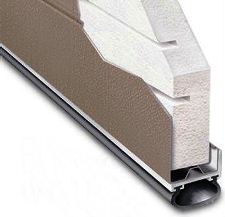Back in the days when I was building pole buildings (I had up to 35 crews constructing them), we frequently had our overhead sectional steel overhead doors hung by a professional door installation company.
Several months after the completion of one particular building, we received a call from the client, who told us his overhead doors were no longer properly opening. His doors would open about four feet, and then stop!
Now this came as quite a surprise, as we had never had a call back on work performed by these installers. The installer was called and he agreed to send a crew out to adjust the doors so they would again open properly.
 To their surprise, the installers found the doors, which were installed as non-insulated doors, were now insulated overhead doors! It turned out the client had (on his own) purchased several sheets of high R board insulation, cut them into strips to fit the inside of the door panels, and glued them into place.
To their surprise, the installers found the doors, which were installed as non-insulated doors, were now insulated overhead doors! It turned out the client had (on his own) purchased several sheets of high R board insulation, cut them into strips to fit the inside of the door panels, and glued them into place.
Those who have used insulated foam board, realize them as a fairly lightweight product. However, the weight of them was enough to completely throw off the ability of the factory door springs to be able to lift the door.
The solution? Replace the original springs, with springs which were over a foot longer in size. The client’s seemingly inexpensive “fix” to get insulated overhead doors, became suddenly fairly expensive!
My caution – if you want to end up with insulated overhead doors, just buy them that way. The door manufacturers will provide the cleanest application, including the right hardware to lift the door, once it’s insulated.







